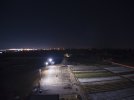Bit of an odd query! With my terrestrial cameras, I specialise in night-time long exposures, including things such as star trails. What I'd love to do is use my Mavic 3 Pro to permit this from otherwise inaccessible locations. The idea is something like this:
- Fly the Mavic 3 Pro to the desired vantage point (somewhere I can't reach on foot)
- Land there
- Shoot a series of long exposures from the ground (or wherever the drone has landed)
My questions are:
- Will the drone be sufficiently stable (assuming it's landed on a flat, solid surface) to allow sharp, long exposures?
- Are you aware of any accessories that will act like a tripod - extended feet or similar - which will make sure the drone is quite stable and secure once landed?
Ideally, I'd envisage the drone actually carrying a small tripod, landing, taking the picture(s), then taking off and returning to me. This might even allow a clear view over obstructions like rocks, low fences and the like. But I realise the drone may have to be more or less on the ground and carrying a tripod is likely to be impossible.
Any ideas or suggestions most welcome!
- Fly the Mavic 3 Pro to the desired vantage point (somewhere I can't reach on foot)
- Land there
- Shoot a series of long exposures from the ground (or wherever the drone has landed)
My questions are:
- Will the drone be sufficiently stable (assuming it's landed on a flat, solid surface) to allow sharp, long exposures?
- Are you aware of any accessories that will act like a tripod - extended feet or similar - which will make sure the drone is quite stable and secure once landed?
Ideally, I'd envisage the drone actually carrying a small tripod, landing, taking the picture(s), then taking off and returning to me. This might even allow a clear view over obstructions like rocks, low fences and the like. But I realise the drone may have to be more or less on the ground and carrying a tripod is likely to be impossible.
Any ideas or suggestions most welcome!










